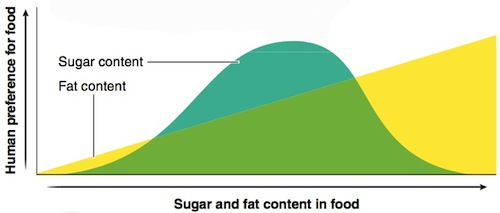Chapter 1. Chapter 9: Human Food Preference
Introduction
Graphic Content Activities

Use the data presented in the graph to answer each question in this exercise.
Question
Oawp+LQyVZ7yF6ldSGwepHCjI3lQSS8KcofAbmIM7Guh8Nx/CmedKjuTK0cdIpJWhjy17C0rwsDO6EA+1gMhHBgwspWgy7/uvBU03zfHFtlmhQ3gCitSAdlSVrIzH7t3jgVqe5pzik7jUowAo1SH3aPzFfzRR82x7FQgizpDc/k=
Right! The value on the y-axis, human preference for food, depends upon the value plotted on the x-axis.
No. The value plotted on the x-axis is the independent variable. Try again.
Question
plRE/mTfKN6Ff1g/2Og6v/T1aBTi3VZR6ZDcH+pFW7/CHJtZKZaGQs/dpxNXVj1DiQt2dL+YRSqS5pPdelyx5SZM96h92Y3sh9idyeBcyC38NTsPshXxKy/ompGsPgApyYtJF/s7hcOllvdazst3QGETWwkcdIOrqKTe2eHfaV0znXwiiU8RmE5/0hy1FNUMiv5KcX5ydFBj6H0wBuOTyNFhH5wntP8WCUthTnTmmx6GK+z2XkNVoiUgZD85WhOtP5EVPgwcapwLemJsDMn3iTnL+/IvKW+B4kObRpjTOgO4B++CaikmJzFLzntmFi7esBZA24/mEu0DNxnOWlr8NBowYU+FJdshMog8wuAYKJhNw5ELCRNvVp5+Y6KaRTjCbLStSY4a3Oe6ngTg14b+uRiUvLv9mBmpil3aPkXoYpbRaVc4+MxVhFe9ewaI5WqQskWliJxue2UIDJHdNnnUAr7S1t7DEWg5rCYb7qozZlxVn6W1Dh2DxATM2llaS9ggoi/jGg==
4
Right! A line graph uses lines or curves to connect data points or illustrate trends across many data points.
Incorrect.
Question
JBZpCoigrf+yaFPVDAwLV+evl5S0r9tTYxF0G3NhW2InzEdonSKZEbLWx9NMizEYnLONuf7qFRuwiztUWeGmwuYxHlP4wyD/cEIqDMhwW83qOGWDecPPFdrm9EB215a93FRMjTpgQmcRfB77JPIarB9LAEEw3ETF4ZAyFCQaP1EN4vp+oxzCLOzPuOw6JrKJaQs4+LHra/OacKvoYlbJeCOPYGkzxs0w8s5vFwXp1I81pGoQ6nZpuv0bdTffMiAOTQpQDIk1v1X8vy7nYa+L6LYjEMrCrwMSGHzutkCjz/dZURFSzNtXy5p+xn64hIV/InEwwKlMv+4nloM3Jo+y9vIy51mzCL4AMIzRVL/qh+eQBWUojH3MkZCGbymVr9V7NG5zhMbERTUV3WYSAkXcauHGDnO4YgGUoFzbqMi7KLXHIwKEiWeDBSuLrP+FZyuB4iRoy21nt0AzrvoLOEO9C8AgdfEPFXuIPNqBQ7Cyh3WwGiiyZ2uOujBxk0E+6R8uqkaoxHo+K/DiSC3AuWm6ZaQtNuDji+r4n77iyfj/2bBJrT/PRBdCJDb9adcAIt1lMaR0zxcRZdP2Y3ksa7DKYF/kRho9kYF6OBl8ZBlOVxvlvKiePVlJbAY7db8WA0ALY4V3FexWfFrYxLAn7Sf9qRSloR+nmDxv0YJWVKwP1aV9T33JahqQwL6PszpAl6rGC0kQ7WdWBU55ZOLBGAKSxf64PwwHlT4KvLEqfYtibS1QtesEiUS+gAUAr7BQbMcLJtLZESTcO14gcyHhIgCjQWhrudhVldGIVyYqE+Qeg4GQwj2f7JkQoL7koKPJhrjD9Bn6fj77i3FHMFa1aYira68DmYlWR/B8qwXloQTjK+QWQgk4bKjI/azT8CHr/8ALfNwgTbyW4F5Wz+mpTjAoWT/I+iFsm3qJvGVjtTsjD4sWgmlC
4
Right. After a certain point, food becomes less desirable as sugar is added.
Incorrect.
Question
JdwsV47Ja1Ux4Qs2QfDw3SNJibijQitU0TJQp64FyknweWNSmD2p7Pv+/dQek9VyGKgC5rkG17mvXarGVWqVJlVDutmn+zS0hOZ5a5fjhKkKMwFws0/KZVUIF4UvvT6poVrmG8hoKVgxfSnJuFjqtArC1cTESVGJgBM1T8zLjMyc0WWuzcFk7Yp/6/aLXgEjFb88PUejdNVeS4s9bn4NXpeHcTI+IDbIPsZ39O5ZbNyP91U4+cHOn3dayXXryxT57CD7wg/SHzQKy0gecGznpV5VkPxro6GW72tgkrA5ws8=
3
Right! The value on the y-axis depends upon the value plotted on the x-axis.
No. The value plotted on the x-axis is the independent variable. Try again.
Question
DbgclPl6swuQIjY14EmK9Oqv7jrS2hbZmoEeeasl/ST8iYrjOFi9ZQenxYL7bk8XttMgNoHNcDArmqO1bcn1hozh6wVV9zVmbcxLP/jtbR00/bCe/4FJUTxaWQoYmLey3TLU1+MRcYq5tdfBTi05bDfxn88fNBWCHzEDm79xt1WUsFAIMQKwrOFN1XdVHbkYL8BkJK9fzh7b9RHLXYGDoTBnKDLjLgPCEEhJy/Y0FKAs8xAkcJXn5xO5XEO1n36Hf47a6BlvTc14MQ13tjavMFMT5SFZGeZR/a0fsGfB0YHN+OMViaB7G3kCmcaVdWjlbGWpi0EQMhaxwgQcOtyHqAZXPm/lxKLU2UCeGmL0PJ3GQMOOm/9vip90pbP3fzaJBQxtC6Auh5btEjgke+vFrHRcJ/jud3i/EPs9ME5Xd4AFfknJ+n0/m0W6wxoGCHd2tMaaXREbzH5gqivHep0caNoGONsqcTpFnsfvK5HiUyg2+cTimNHQsPQyGL69nHcQRCLqms26hh1l6R6dmDEaK6YEuOo2WFPlzybU8tzFc3f1iKhNL5EDDCjjN5aOdGIF3tkNeijK5SNdMBx2VwLx5S4mH0O5kqRjt3byS3x6UMEQAaTKJxmI3M5saoF7LFkUz+7uJuyKowmLt52FrwEFfP8fbQ4AgS9QEK37ECYzPiX4O4T+xAY2/Q11fUnrbJDb9CtywcV/mmFsnTGHIhrhFnAcPiM8U0LpsONMc6Ut95RVtKDuRrwfath/r38NP5SsTg7X+/XRWWrsDPL0Gjevt361FJtMYLzNEpht8hRerWs9rM5Kd4BbW7hfGJJ8VzKs/meIxBNcN5a5MjZdDx2zr3Z58uTCn1w7vPOTVBIqkb6XxDOtrDKK3m90P4QhYccojWJ63viz02QJVBLiyewP2K4SrSIUvsNP8XXU+cFrNDX5us67ppQ20t28VHPT5bBxQtJd1u0fBMIU1MnemP90MJp4//U=
4
Right. The upward slope of the line representing "fat content" indicates that, the more fat a food contains, the more desirable it will be to the human palate with no limit indicated.
Incorrect.
Question
ZpajZhsJ5Yi80bG7k+D6Sp71sM7BNwruhp8XIlTN7M9GdrVSEo8zWAtq6SA8qR8xG8DycnXpjo4AgYJFCkjouihxCd8A6I946VOqp+h7/zCUvNZsofaA8a6S6a3d7jPaPplyZ25il9L6wnAK6yNQsGRut9RSE4E+cDQ562CnBuM6o5Jvs1icCBdMFXYpBwbCDV0yp6k2jdaJeEqgQjYe0+YtKfLEXR09+CSAx9BmyW+MZNaICO+DSCnvNkMMW+El/KL05bPVgUIaJR3S//iCpJS1UefgZ2eA3fGbpeLpHBjb9GRk8bDsDQ1omK2nVI5fjzuiCghSGp15QKG6/Uil+7xrQWvcs8WD1I3kD1HN6es20xskeYR1YFLGP3lvySWLJe31FE4IFFj30wf5jVxXsjHKrad2e4mWilVnDgwN3aRGxKRw1fUysDQs8dTnE2c/3uwy9YtOgGKABtJK7v4IVGx2k3rJfgFk8z1KRhAURzuLIhxM6uwFOnI7mPk/TR3uZOzQ4Lq32BTYaq4ATyzRA4K4aW3/rULM7+LZ0NSkZ1ow1hHGAYiLWTATfrEtayf3GmNHi1mOeMQGmFsgvWUIQ6zBbq1rBylLmlf5JZ695JGppT2adu58iQBV8LXUZTJ1KmjYotebvZqNdNGf3TfNqf9hoFdyrW9zcgBJ0EDlK7qSGWzgbMNdAeoUTXUQMngGbP3Tgm0m53p7B3i0uZA9wFcI6ec0RsZQoqg/c3gSLkJS04ADr/UnyL69/qsyOvP8YigTK/ODprCEOBaAZACWX8hqtwAFsaV3hxAHcMgFkHzVJfsyJsVWjEGjapOaJuqR19G4ldlRpbPQ6LySLjj1j1ohETJA0yjOZh5GsymW6+MMXhH3KiHWBNKrpDaD0H1MMkpGgxiKsW5YzryyeZWKHVsXfmh7SCUxJm2etJ96b42lIM4FiLOE/RECsAcE1VR27S/BN5c/JMgZyU74NrGOC5ITSK3QY1a0SKzhKM5uBBdbGbQZtz9pAyCVSmmwtviomn0hCSx3z1SwClhbqtJevEyLogOkzBwAgGbhH98kYI8fw4TPWXMKiETvxM77i+mZrZs/c4iQHZcO5H72HnSR1YVrJ0A0U5inPb80Daw/C45+OrwqPGTzkUyk7asxDHmX632JfGnX5f2Kw3JbQRbtow7L9EnD7WIlVmZi5lr0mLe00qjypKPrvYArNiuiyCbgocvtEfKZJFYx9+4GLjq+3q7V/L4WiNTEnXgRcOvVsyWEMCO61coLtFco+dbhPsx9AahR5h/6HolhmhMBiDRm/IH58yHY8ucPZo8j/gGIhf682j1+eQsNj9DTZKZ4U12vySukLdriOvAgSlDcWNNiQlU1XQDWnk67tm46S+PMk+/ZSlOlNtauBlB0kKHcgwprNqpm6dZLs4yguuKXSXpFw5OIGWPlzxRkKhPgog==
4
Right. Human preference for food increases as fat content increases, however as sugar content increases after a certain point, desirability decreases.
Incorrect.
Question
c+nLMIPQCmpPx/Ofnvhl1uIq6gTzQP4c/eD8PjyEQ9HX9LSqKxv7afrqPLGZW9/brMHa54UuXazspLLFjqYp2gWI8Vk+gLX0kBlOesb4faPsJJCZzdXb1S3vvYTVsl9w4wZrzlpQYniDzRpUQX7UoOy6qkQNBIXkBZ8OuMQB0gBieThXcWYvgHt87HRBHGmF+gCWzULbkLsq58ocTomFFfoFw/OdbqC/U2i5kDFYGY9gBDztsv3BYunUoU+7Uo5AW4ray4jQi6D/zyUrmZgH+EinrPkTnW9CJPqLI29iac2uBcsrHvZQ58dQTZhPJWrjv6iJNYpClUpPH1AXt7icqSvd0D3Oo0qLEQuMgGW2s8dM9IMxWzzol/XIuEU1mIv7YuZg9iNfn8leeKIYvHPBMXLZsxFipb2/HSGZIUJfR4l041dF6YySEV/yP10RsYI0tQE3ksQ8ixz3Jwz+aOJ41+4wttf1GxrecYGqz5XpJ2VVuNmBjrxx47J3ZCIGL3lAVjlNlSu0YusSGpngNaHN6f+ZfQjoBPFSov9Xgu8T6Qdc4O8dcfFvMMtZFB+clTGWUOjIMxp4ZSlA/wkfH3DgjuJVdrF2hjGcZR25DAnFDc/iUPwDDccaQ7v76FJEOMOrtuQUheFXEBGAB2wcjUip+wq0yqu4UeuhpG1isXj0KUm0Js5KzTQd3Tk/PmFbueJACA8CQ1+UOYdBKsmyrXo+SHcinJStC7896N3vTSon3NlcXlLsgfeK25jwhnfBGOCR2zPndRplOIpFomEZmG6OWRXUBU6+WZB2P+oPBqtaHt2ahsJaUxGMMjGg9WZZiOVVJM3spmEZQb9adagGQZ7bWJlqdNq7uCXGJcXwXqLY17R3r8s6ytTuV4KuC/YMpR0ep3dzAO5WzA7L8RDHvXHPRIZBGY516BHzT/igtRzs+fJXXRrDFS0jvoOH45o8vkX651Gwx28VYE31UcCxw7XWxbsc4eGyuenpP0c6ChDg3HxSWE6fHnxTgR6iI7ipCZySXPllB2/bd3b+Luc5qhZlIaBA2G5rpNKvqlUCM94X5LcBCLoMdcMqZPraJ5RafJmIJ24SR6RN0v6hD0Y/pLclFBVjd3096fKkC4Gopl3QHUYkIV4pBSU1yW7TXE2AVz3MvuHFAt68/jkn8s2fh8j3WNq8mdk4PmCqnM/0m2m/gkA=
4
Right! The graph shows that, while adding additional fat content makes a food infinitely desirable, adding too much sugar would make it undesirable.
Incorrect.
Question
webZamWS+lCGfB8vIulZk+hLN3b5oqviYVsJQ0zmgBXl4fdvYQmWiklUZjMvLZZ/s5s+pp3Ys0Z5tbAvvxzUnsZLV+IP8E/X1TeYtYBM9k3x1ypU6eIccQQzu+Phx+GsyRBF60jgnd8BXdGO22SwSZ9N3nrNGpCuacRDIRdfEfF/56YjM9vkn/5BjRT1O1mjwTWOXAxZHZd9m5cnW2e6MwLSxRz4Jty0oH+LkZdjCdr220fzZlAVnLXjsyiEPg74rOulBB5QIdUAKBpJqvodrqHNDKnN/0u/XZlkdsHGtV53i0BEmd1hm3MfhPHKQbg+uCu2RF/iZEfYHrL83XWgVxxji2stL/ca0k8ZB85rXw0Jx0C5ygcAgwTdgvQ/DevITdj0yHU2o+Udx1K34MYPxFlvTpKlFA7JutKGAkT7/HW1Ae6jBYycaYjhQLFEJTavScAeoIrE0Nw5gTFwzooPsm+XSI66YHKXR9H6YGpRCluic7SyMxy5D1MlaxlIoTBjunq4wrtGU++RShXoGEGp7PokWEZU9No57/0a12gDjJDah1+3VwXtwZbNG1yp02y0CdiYNvyHkJypzvMNp5qCNKABk813VYSEriP19CGDZi2wwD2ele00sJCHSPu+ejcjED+gsRivI6NqDCLzUZ/5yYAA5WmtMvC1UJH1suSaoiOI4pKGrfHAmUuEokq3eFN4cLfcY3UW44HLUgiuMfrgy7iMFNeLUe/NUcIrp35fqJg8eNYqVzb/eU99KmwmqZFnrax2MteiWO3MjqPtooO6j0lRCdxgX3hS3bQSELbg7/kTp4kySVBqfVSoYM+iQq4lmm1oqx/Far09rImDzi5+S95HFtjjx9Jg3w6tmzRxwnPwHBeqi5homJtzm7axk5iAo8I4yu9jkl6y2wadw3Gjn81suC8oTE240GisrHbBRwTz0HTn/qsbXfVL5ZReXK6UOkW+usmK8iBGFaxTPV8PPShyZJlhpr3JpWxYXIyalxKDhRF383ugEtlPoK9pXyYPbhKY6GyXfJCN6e1T3H3ciZLLy8nBRlWDsBoytNVkupTSoSf8VTG76D+7MQnIbnNnGtvGLA+VKd8p85xfDgLlvT+hz4GYGNgYr3Vtb4pglPFNHrhpiqkfRA1/dZLmJKiBmn08V606OoBhgT7Dc15z/MeZXRVQx2nc5HtDr3QufWi2sB5bniggn5t76ccEm13ideW0HHllAN3f/DxEPjdxqOO4TptisNkcBVf5avclePfORKrAz/Rhpjn561NYwcbLvWh4oCn4zPxkfIBzy3IqRdVLKIx0xzDN4piZUWx/dEY30MOWlW8SP+gZWg22/YkqIRTVpp4lI9xV9Ldis+ggGiEoBMbQUeVNqWZH0VR3W542O41gUjVn+PoRKOu+cnb/SF5r3wGHEAz9W4SrbdgG7vkiuklagy8kctafSzUQRltC+fStqCb4SbPUWSJOU6DaudTrKGRduHU19fP4KCCWxed9Tvr2m8WP6Pvch0Toof+9TSVQSy/F8T9Ny/Ej6Q3DL4c3bMkSNM4gFho1iZmD7f6a9gWmS9cpX76u0Z930f4WCF994mQAu295l292l+MA1cCkjfP0IODiLlXT/uWu3j0Wiofsa54LltdXQ5HF3I1+Qh7AAH27FeYBvZRgbXQEAqx7OGm6Q1gKyf0f7kfROZCTgafxqqaQJhAWC3fXwbjh2POummDGmlD0mhWZTi9T9RGrGLKYalm3RWOQbr569n4ly7RKijjeu5QMJw==
4
Right. Humans' inherent preference for sugary, fatty foods paired with increased availability of high-fat, high-sugar foods provides solid insight into why these foods are more prevalent in the average American's diet today.
Incorrect.
Activity results are being submitted...